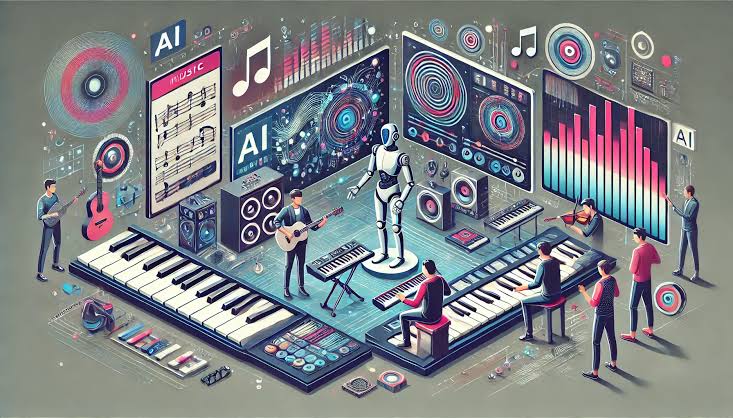The emergence of artificial intelligence (AI) has profoundly transformed various fields. One of the most intriguing areas of this transformation is realm of music and sound art. AI-generated music and sound art represent a convergence of technology and creativity. They push the boundaries of how we understand and experience audio creation. This exploration delves into the mechanisms behind AI in music. It examines its impact on creativity the philosophical questions it raises and its implications for future of audio art.
At its core AI-generated music involves use of algorithms and machine learning models to produce audio compositions. These models are trained on vast datasets of existing music. This can include everything from classical symphonies to contemporary pop tracks. By analyzing patterns in these datasets, AI systems learn to replicate various musical elements such as melody harmony, rhythm and timbre.
One of most common approaches to AI-generated music is use of neural networks particularly recurrent neural networks (RNNs) and generative adversarial networks (GANs). RNNs are designed to handle sequential data. This makes them well-suited for music, which is inherently temporal. These networks can predict subsequent notes or chords based on preceding ones. They generate coherent musical phrases. GANs on other hand, consist of two competing networks: the generator which creates new music and the discriminator, which evaluates and refines it. The iterative process of these networks enables production of increasingly sophisticated compositions
Another technique involves using reinforcement learning, where an AI system receives feedback on its compositions and adjusts its outputs to improve over time. This feedback can be either explicit, such as human ratings, or implicit, derived from how well the music fits within a particular style or genre.
Impact on Creativity and the Artistic Process
AI’s role in music creation extends beyond merely producing compositions; it also influences the creative process itself. For musicians and composers, AI tools can serve as collaborators, offering new ways to explore musical ideas and structures. For example, AI can generate variations on a theme, suggest harmonies, or provide alternative rhythmic patterns. This collaborative aspect can inspire musicians to experiment with forms and ideas they might not have considered independently.
Moreover, AI-generated music challenges traditional notions of authorship and originality. When an AI creates a piece of music, the question arises: who is the true creator? Is it the programmer who designed the algorithm, the AI itself, or the data that the AI was trained on? This blurring of boundaries between human and machine creativity raises philosophical questions about the nature of artistic expression and the role of technology in the creative process.
Philosophical and Ethical Considerations
The intersection of AI and music also prompts a reevaluation of the concept of creativity. Traditional definitions of creativity often emphasize human intuition, emotion, and intentionality. AI-generated music, however, operates through algorithms and data analysis, devoid of emotional experience or personal intent. This raises the question of whether AI can truly be considered creative or if it is simply a tool that extends human creativity.
Ethically, the use of AI in music production also brings up concerns about copyright and intellectual property. If an AI generates a piece of music that closely resembles existing works, issues of originality and ownership come into play. Musicians and composers might find themselves in complex legal and ethical situations, especially if AI-generated works are used commercially or attributed to human creators.
Applications and Innovations in Sound Art
Beyond traditional music, AI is making significant inroads into sound art—a field that explores auditory experiences in innovative and experimental ways. In sound art, AI can be used to create immersive soundscapes, interactive installations, and generative sound environments. Artists are employing AI to design pieces that respond to environmental data, such as changes in weather or social interactions, resulting in dynamic and ever-evolving auditory experiences.
For example, some sound artists use AI to analyze and interpret the acoustic properties of specific locations, creating site-specific sound installations that transform the listener’s perception of their surroundings. AI-generated sound art can also be interactive, allowing audiences to influence the music or soundscape in real-time through their actions or choices. This interaction adds a layer of engagement and personalization that traditional sound art may not achieve.
Future Directions and Implications
As AI technology continues to advance, the potential applications in music and sound art are vast. Future developments may include more sophisticated algorithms capable of generating highly nuanced and contextually aware compositions. The integration of AI with other emerging technologies, such as virtual reality (VR) and augmented reality (AR), could lead to entirely new forms of auditory experiences.
Moreover, AI’s role in music education and composition could democratize access to music creation tools, allowing individuals with limited musical training to compose and produce high-quality music. This could lead to a more diverse range of voices and styles in the music industry, enriching the cultural landscape.
However, it is essential to address the potential risks associated with the proliferation of AI-generated music. Issues such as the loss of human touch in music, the potential for AI to perpetuate existing biases in music data, and the need for ethical guidelines in AI-generated art must be carefully considered. As AI becomes increasingly integrated into the creative process, maintaining a balance between technological innovation and human artistry will be crucial.
Conclusion
AI-generated music and sound art represent an exciting frontier in the world of audio creation. By harnessing the power of algorithms and machine learning, artists and technologists are exploring new possibilities for composition and auditory experiences. While this technological advancement raises important philosophical and ethical questions, it also offers unprecedented opportunities for creativity and innovation. As we continue to navigate this evolving landscape, it will be fascinating to see how AI will shape the future of music and sound art, and how these developments will influence our understanding of creativity and artistic expression.
